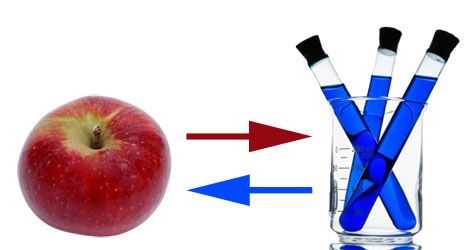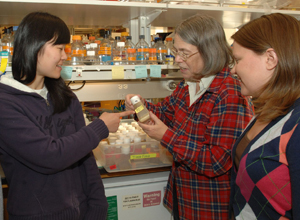
On Jan. 12, a bleak commentary in Nature online suggested a funding bubble in the sciences is about to collapse with dire results for science students. “When the economic storm struck in 2008, the ride came to an abrupt end,” wrote Colin Macilwain, a contributing correspondent at Nature.
“As Western governments attempt to maintain investment in science as a route to innovation and industrial development, they are undermining support for students and the quality of their education,” Macilwain said.
“Students are not customers of a university; they are its very soul,” Macilwain wrote. “The idea that research will prosper while teaching and learning decay is a dangerous fallacy.”
Two days later, in the Jan. 14, 2011, issue of Science, Sarah C.R. Elgin, PhD, the Viktor Hamburger Distinguished Professor in Arts & Sciences at Washington University in St. Louis, and 12 colleagues took issue with Macilwain’s fundamental premise.
Elgin — a professor of biology and of education in Arts & Sciences and of biochemistry and molecular biophysics and of genetics in the School of Medicine — and her colleagues don’t believe teaching takes place at the expense of research or research at the expense of teaching.
She and her Science co-authors write that “excellence in scientific research and teaching need not be mutually exclusive but are instead intertwined and can interact synergistically to increase the effectiveness of both.”
The authors are biomedical research scientists who receive support from the Howard Hughes Medical Institute to create “new programs that more effectively engage students in learning science.” So, they admit that their situations are more favorable than most.
Elgin comments as well that Washington University has the resources to fund programs out of the reach of state colleges, even in this time of financial hardship.
Growing the middle class
Institutional missions differ, Elgin acknowledges.
“At one end you have research institutes that do nothing but research,” she says. “And then clear down the road you have PhDs who are working in high schools and junior colleges where there is no expectation that they will do research.

David Kilper/WUSTL
Writing in Science, biomedical research scientists, including WUSTL’s Sarah C.R. Elgin (middle), PhD, envision a future where the teaching of science and scientific research are seen as equally valuable and mutually reinforcing.
“What we would like to do,” she says, “is increase the middle class, if you will, and lower the number of people who are viewing their role at the extreme ends. We would like to see situations where the people whose entire job description is the interaction with students nonetheless thinking of bringing students into the research experience.
“On the other hand, we would like to see people who are entirely focused on the next research paper step back a bit and think more about how that process is training the young people who are working with them.”
Elgin and her co-workers recommend seven steps that universities can take to support the teacher-scientist, ranging in difficulty from educating faculty about research on learning or creating teaching discussion groups to creating (monetary) awards and named professorships for outstanding teachers and requiring excellence in teaching for promotion.
The complete list can be found in the online article.
“I think Washington University does a pretty good job,” Elgin says. “There are many institutions where there’s a much greater dichotomy between expectations and rewards for teaching and research than there is here.”
Nonetheless some of the steps, such as requiring skill in teaching for promotion, have been notoriously difficult to achieve. The problem, says Elgin, is the difficulty of establishing a rubric for excellence in teaching that is as universally accepted as the rubric for excellence in research (journal publications, citation indices and impact factors).
Teachers as students
Elgin has more than seven ideas for encouraging teacher-scientists. One of the most interesting is that faculty be encouraged to take “teaching/learning” sabbaticals once every seven years. In other words, they should become students at the institutions where they teach.
Elgin, a biologist, took “Calculus 2” in spring 2010 and “CS 131,” an introductory computer science course, in fall 2010. She didn’t audit the courses; she attended all sessions, did all the homework and took the tests.
“It’s really an illuminating experience if you’ve been teaching 20 years,” she says. “I had good dialogue with Roger Chamberlin, PhD, associate professor of computer science and engineering in the School of Engineering & Applied Science, and Ron Cytron, PhD, associate chair of the computer science department, both of whom have taught CS 131.
“The CS department was very accommodating and provided tutorial support for me when I needed it, which was frequently. Now Ron is going to take the introductory biology course this spring. We have a tutor lined up for him because he’s going to need it. Faculty don’t have a lot of spare time, and a good tutor can help you enormously.”
In both cases, the tutors were talented WUSTL undergraduates who have recently completed the courses in question.
“It seems to me that you could really change the vibe on a campus if every faculty member was a student once every seven years,” Elgin says.
This summer, Elgin and Cytron will be trying out a new version of the computer science course that includes biology-related labs.
Doing it all
Elgin admits the worst enemy of the teacher-scientist may be exhaustion. The culture of science education “must be sustainable,” she says. Fortunately, genomics and the Internet offer ways to avoid an 80-hour workweek because they allow digital sharing of lab prep and joint curriculum.
Seventy institutions use Elgin’s Internet-based lab course “Bio 4342: Research Explorations in Genomics” to incorporate research in comparative genomics into their undergraduate biology curriculum.
One participating teacher said to her: “Thank God — I’m teaching a lab course, and there’s no prep! I don’t have to get up at 7 a.m. to make sure the enzyme works before the kids show up. I don’t have to do the bench prep.”
“We can make this sustainable by lowering the energy barrier,” Elgin says.
It’s important that we do this, Elgin says.
“One instructor in our Genomics Education Partnership told me the students said this was the only course they had in their college career where the answers weren’t in the back of the book,” she says. “Students won’t understand how we gain new knowledge in the sciences unless they have a chance to do research. And that sort of understanding is the goal.”
We want our graduating students to join “the society of educated men and women,” Elgin says. “And knowing how new knowledge is created — and that you can make a contribution — is key. It is this dialogue between our research and our teaching activities that generates the results we want.”